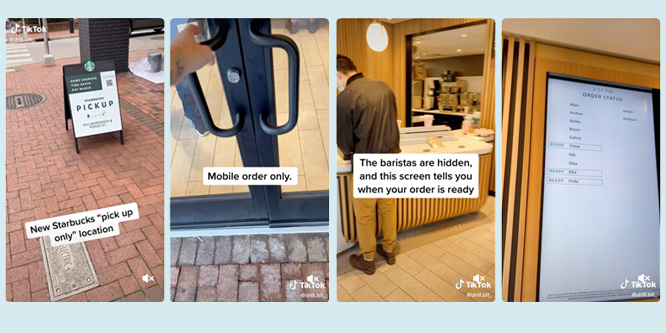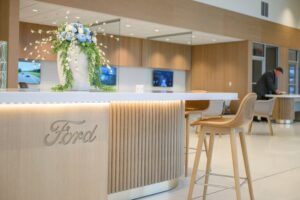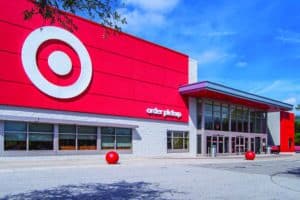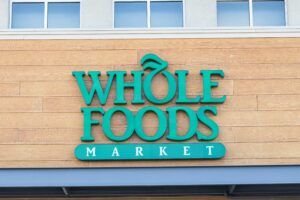
Source: TikTok/@allenztucker
March 30, 2022
Have people had their fill of contact-free retail?
Contact-free retail became a priority, a selling point and a necessity for retailers at the beginning of the pandemic. The efforts by QSRs and other retail locations to cut down contact with customers, however, is raising questions about the threat of compromising the customer experience.
A viral video on TikTok from earlier this year depicts a new pickup-only Starbucks location at Hillsborough and Pogue Street in Raleigh, NC. The clip’s narrator says that the baristas in the location are “hidden,” a fact that did not sit well with ZDNet contributor Chris Matyszczyk, who in his assessment of the video, lamented the loss of friendly customer interaction. Further concerning to Mr. Matyszczyk was the enthusiasm of people purporting to be baristas and ex-baristas in the video’s comments, which celebrated the outlet as a perfect place to work, as it would theoretically prevent unpleasant face-to-face customer interactions and confrontations.
https://www.tiktok.com/@allenztucker/video/7067650854991613230
Not all baristas appear to share such negative sentiments about customer interaction. GeekWire reported that when the first Manhattan pickup-only Starbucks opened, baristas complained of the layout making it difficult to connect with customers, leading to a redesign.
Starbucks is not the only QSR now offering customers an experience with minimal human contact.
Canadian restaurant Box’d has fully removed face-to-face interaction between staff and customers, according to an article in QSR Magazine. Box’d, which launched in mid-2020, allows customers to order via phone, computer or in-store kiosk. Within 10 minutes, the order is prepared by a line chef and deposited in a glass cubby. The customer’s name appears on a digital screen above the cubby, where they can collect the meal. The restaurant has continued to have success as pandemic restrictions have eased, and is planning to expand into surrounding areas.
No-contact transactions have also been catching on in the grocery channel.
For instance, a ShopRite in New Rochelle, NY, has been utilizing a completely contactless “pod” to facilitate grocery pickup at any hour. Customers can place orders and then pick up their groceries in a tote at a secure, free-standing pod outside of the store.
Albertsons is testing a temperature-controlled locker program at some of its banners that will expand the ways customers can get their orders in a contactless manner.
- I just watched a controversial Starbucks idea in action. It put me off coffee – ZDnet
- How One Fully Automated Restaurant Continues to Thrive – QSR Magazine
- ShopRite Unveils QuickCollect GO! POD Smart Grocery Pickup at the ShopRite of New Rochelle – ShopRite
- Future of coffee ordering? Testing Starbucks’ new pickup-only store in New York City – GeekWire
- Albertsons offers a new refrigerated take on store pickup – RetailWire
Discussion Questions
DISCUSSION QUESTIONS: Do you think Starbucks and other QSRs should provide pickup-only locations that offer customers contact-free service? What do you make of the barista reaction that the job would be a “dream” because of not having to deal with bad customers?
Poll
BrainTrust
Lee Peterson
EVP Thought Leadership, Marketing, WD Partners
DeAnn Campbell
Head of Retail Insights, AAG Consulting Group
Recent Discussions








From a customer perspective, and with the pandemic on the wane, pickup-only locations are not necessary. I thought that the original Starbucks differentiator (the coffee is not great) was the interpersonal ambience…
Ultimately, all of this will be driven by consumer demand. There is a demand for contact-free options – as is witnessed by the growth of concepts and services like cashier-free registers. However many, many people also want service that is provided by a human being. So companies are going to have to provide both. In my view this is not an either/or, it is a hybrid.
For me, fast food is typically an impulse purchase, made on the run when I happen to be passing a favorite QSR. And sometimes it only has to be a “barely acceptable” QSR, depending on my circumstance. If I’m going to take the time to order and drive to pick up food, I’m more inclined to go elsewhere.
The core benefits of a physical location are twofold: human experience and the ability to offer a hub where all channels meet. To limit a store to a single channel is wasting the value of that real estate. Retailers who understand their stores need to be designed to serve both online and offline customer interactions are the ones who will succeed. While offering a self-serve option in stores is vital, it’s equally vital to allow that customer to change their mind and ask for help. Turning customers away in the store because they want to engage through an employee is the quickest way to send that customer running to the competition.
As much as many people may be done with the pandemic, the pandemic is definitely not done with us, and there are millions of very vulnerable people who must still be extremely careful. Contactless pickup options will not be feasible for every brand and even in every location, but including safer options for vulnerable and/or cautious people where possible would ensure those customers could still shop with you with confidence.
For any brand the size of the aforementioned, options are key. Sometimes I just want to get my coffee and run off, other times I’d like to sit in a nice space and talk to someone and at still other times, I’d like to have it delivered to my house. Fortunately or unfortunately, that’s how the modern consumer thinks: “how can this brand best serve me today given MY schedule?”
The pandemic made a lot happen but with today’s consumer, they were going to gravitate to brands with more options sooner or later anyway. Personally, I love it!
I tend to think if retailers have gone this route, it is because there has been a customer demand for contactless service. Every retailer will have to make that decision independently knowing that they will not be able to please all customers.
People who prefer self checkouts over live cashiers will love pick-up only locations. The rest of us are tired of the world created by the pandemic, and we are over bad service hiding behind pandemic-related procedures, because in some places that’s exactly what it is.
If you are in retail you will always have to deal with bad customers. Putting the baristas behind a wall won’t stop someone from screaming that their drink order is wrong. And if there’s no live person to interact with it might even make the situation worse. Still, if you’re in a hurry and you just want to grab your drink and go, these locations are just the thing.
There’s always going to be a value for instilling “reverse personalization” into the customer experience – where customers are aware of, and interact with, real humans that deliver that experience.
That said, there is still a large segment of the consumer population that demands contact-free service. And there is a large segment that demands full contact (well maybe not full contact?) service. There are employee segments that prefer to work in either side of that spectrum as well.
With that, I don’t see this as creating an either/or approach. I see a need for a blended approach. For retailers with multiple locations, I can see a need for designating some as contact-free and some as with contact. Then let consumers decide where they’d prefer to go.
Certainly, data led them to think this was worth at least testing, to learn, to evolve. I like it! It establishes a process that can be further optimized with engineered standards, as you eliminate the chaos injected by the walk-in and order process. It’s basically a human-driven vending machine, a ghost kitchen as a point of pickup. However without lockers I do wonder how Starbucks will handle theft without some deterring presence.
Customers love contactless retail, especially at QSR. It’s clear that the baristas have differing views on customer interaction. Probably because many customers fail miserably at human contact. If you have seen any YouTube videos of customers at these locations flipping out, you would agree with the “dream” comment.
You don’t have to see too far into the future to predict fully-automated Starbucks locations. Let’s call them “fourth places.” Not all Starbucks locations, of course. But why isn’t there an automated Starbucks in every highway rest stop already? You know, like a pit stop at NASCAR, but without the people. We want immediacy, and Starbucks is already delivering on that. The hard part is trying to be all things to all people when you have over 30,000 locations worldwide.
The notion of not interacting with customers because one doesn’t want to deal with “bad” customers is diametrically opposed to everything that retail is. It flies in the face of what retail is all about, which is developing and offering unique and differentiated customer experiences, and then learning from them to continuously improve. Looking at it from an opportunity cost standpoint, I’m not a fan of contact-less pick up locations. I’d rather invest similar dollars in physical/digital facing initiatives that draw the customer closer to the brand franchise, with in-store, in-drive-thru, in-parking lot, in-app touches so frequent exchanges can occur. Though these moments of exchange may be ueber-fast (10 seconds to 1 minute), they are incredibly important and a currency for feedback.
In an ever more socially distant society, where many people actively avoid interacting with others, is it much of a stretch to see a Starbucks staffed with robot baristas? Robots never vote to join a union.
It is a matter of location, labor availability customer preference and costs. They have the data to see how many orders are coming from app versus in-person ordering. If a store location is has way more no touch orders (such as transit locations) it makes sense to switch to that model. For locations where there are more walk-ins and dwell time is higher in the sit down area, personal service is better.
I do wish Starbucks has a stronger policy against the social media people who come in with the 20 plus ingredients orders or film the cashiers while they are working, or worse throw drinks at them in the drive through. I understand customer first is important, but that’s ridiculous behavior to enable.
The consumer preferred contact-free service may have morphed from virus-free. I believe it’s going to depend on the context for the service, i.e., in a busy traffic environment vs a more leisure filled opportunity. So going to work (not working from home) is one situation where contact-free is a real advantage/convenience. As for the barista reaction about bad customers. I guess flight attendants would like to have a contact-free environment as well.
Whether or not to offer customers contact-free service would depend entirely on customers’ needs. The motive behind implementing something should not be to keep up with the trend but to provide an excellent customer experience. Customers like returning to Starbucks to experience the quality of interaction from the store staff. By automating pin to pie in stores and completely eliminating the interaction part, the chances are Starbucks and QSRs will leave their customers with unsolvable choice paralysis and create dissatisfaction.
Speaking of baristas’ reactions, I am not sure if it’s the right approach for someone working in a place like a cafe. The sole motive of automation should be to encourage workers to focus on improving the quality of engagement with walk-in customers rather than performing monotonous tasks in the kitchen. Customer interaction is a part of the product experience in the case of cafes and should not be eliminated.